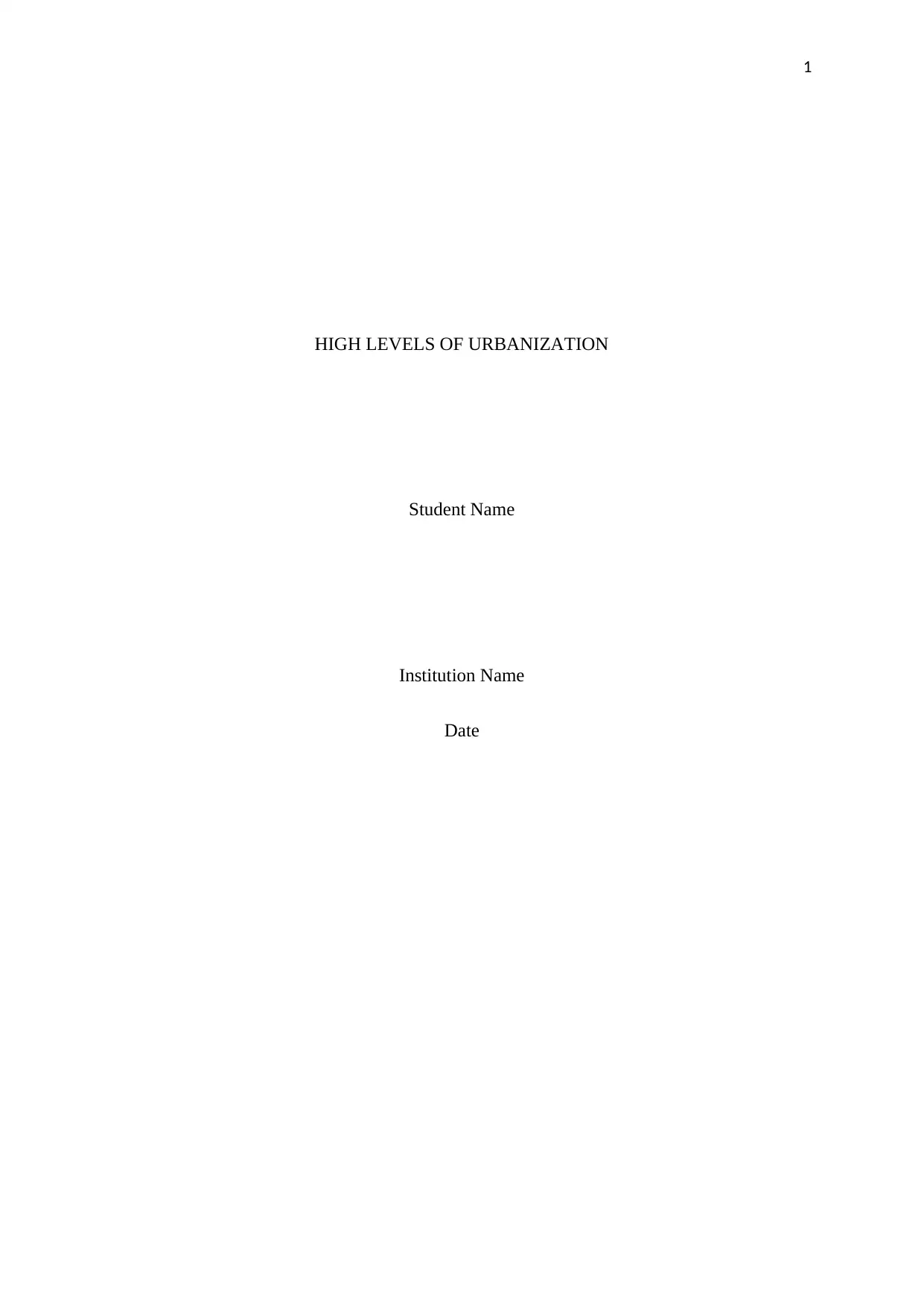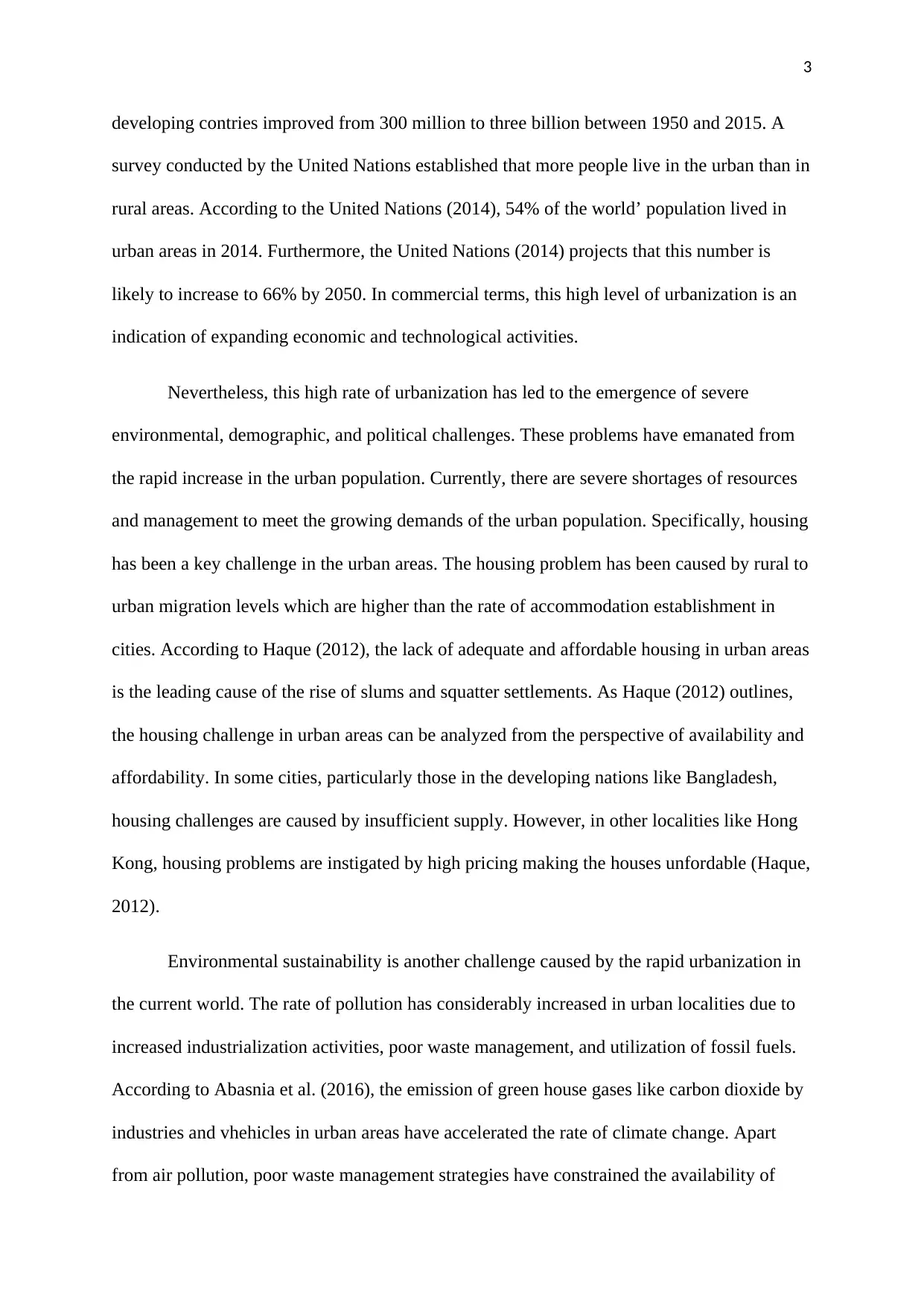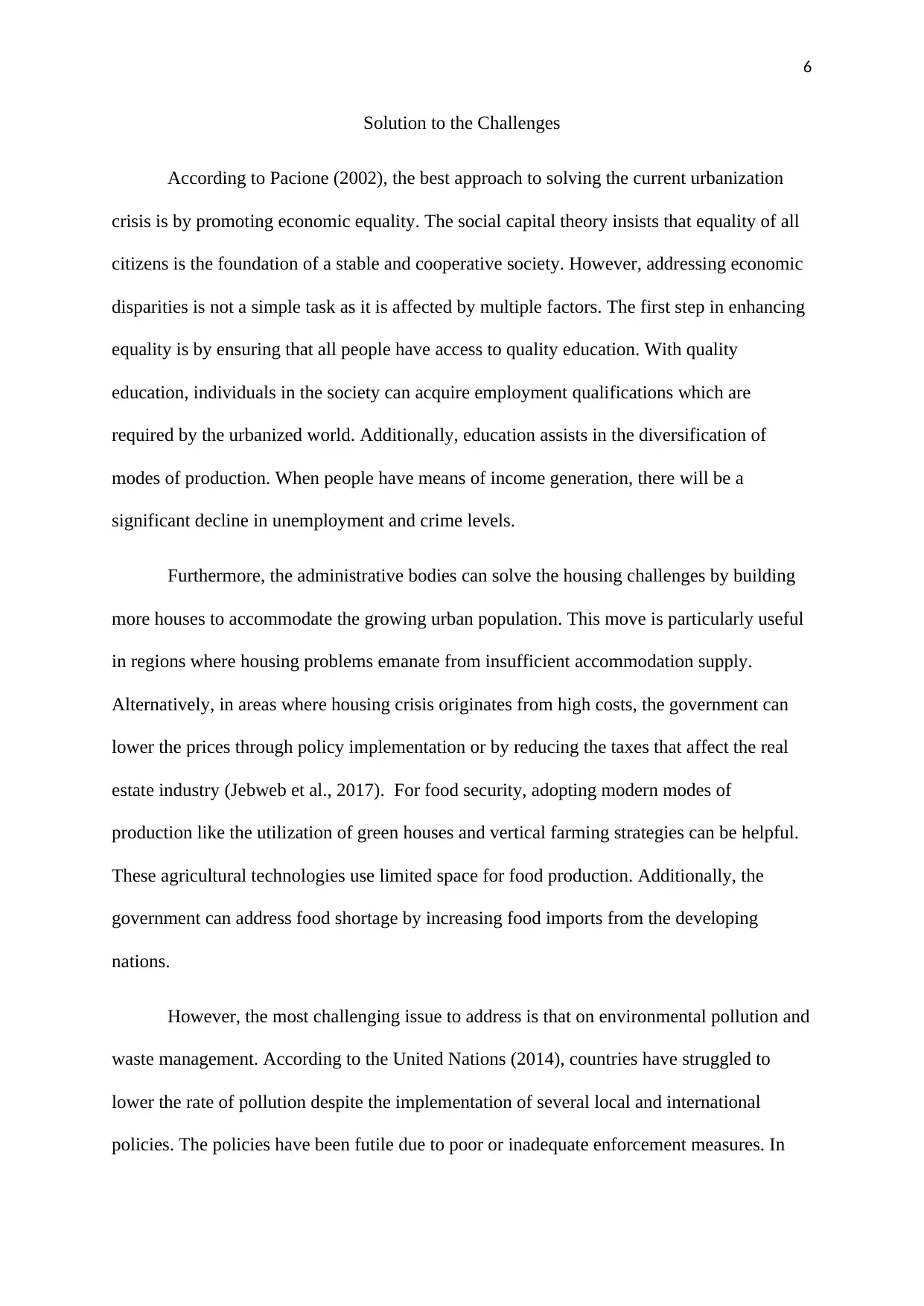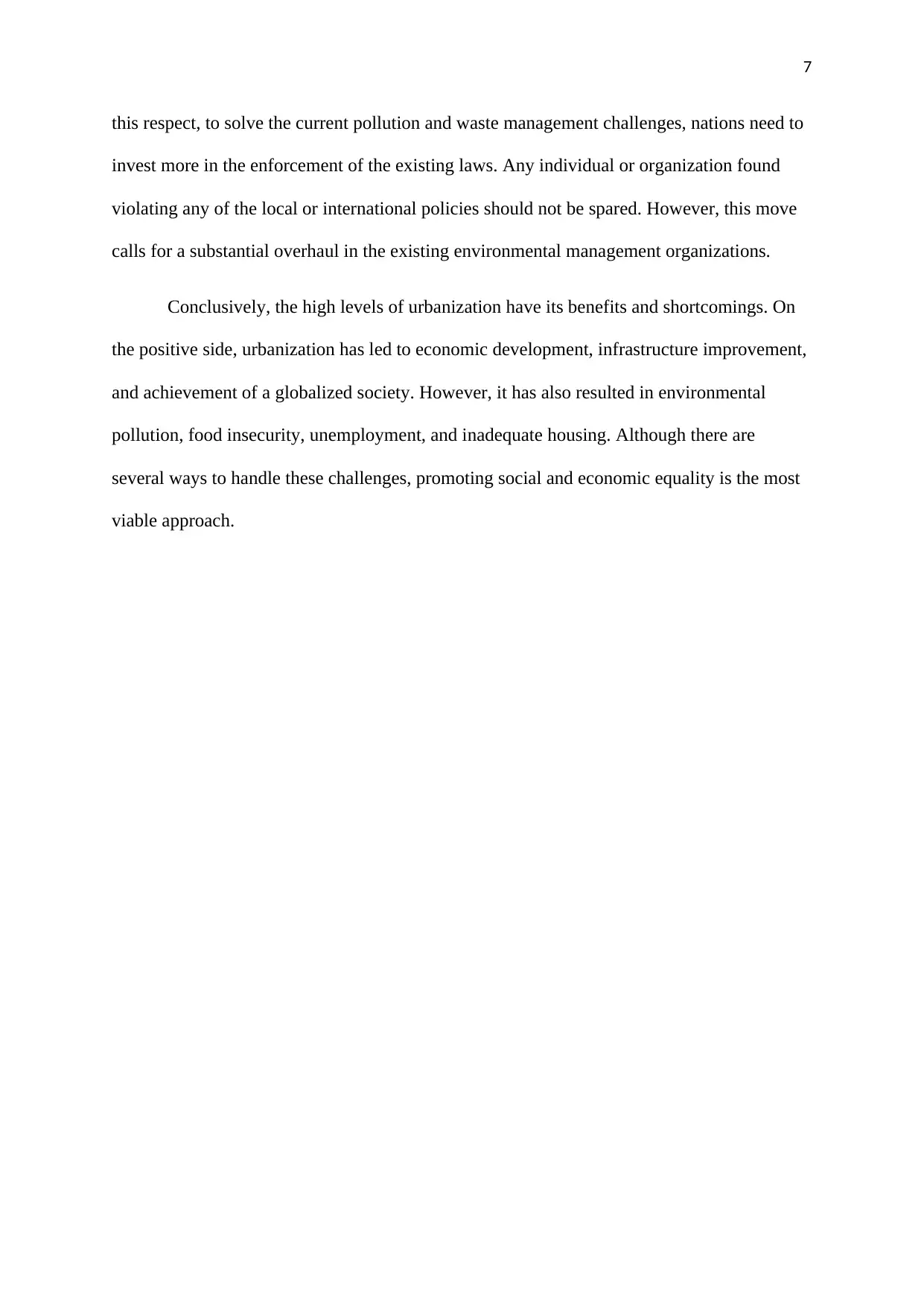Challenges of High Levels of Urbanization: An In-Depth Essay
VerifiedAdded on 2020/03/02
|8
|2040
|441
Essay
AI Summary
This essay delves into the multifaceted implications of high levels of urbanization, exploring both its advantages and disadvantages. The essay begins by defining a city from various perspectives and then proceeds to analyze the significant challenges that arise from rapid urban expansion. These challenges include housing shortages, environmental pollution, employment issues, food insecurity, and rising crime rates. The essay highlights the complex interplay of economic, social, and environmental factors that contribute to these problems. Furthermore, the essay proposes potential solutions, emphasizing the importance of economic equality, improved education, housing construction, modern agricultural techniques, and stricter enforcement of environmental regulations. In conclusion, the essay underscores the need for a balanced approach to urbanization, promoting sustainable development and addressing the critical issues to enhance the quality of life for urban populations.

1
HIGH LEVELS OF URBANIZATION
Student Name
Institution Name
Date
HIGH LEVELS OF URBANIZATION
Student Name
Institution Name
Date
Paraphrase This Document
Need a fresh take? Get an instant paraphrase of this document with our AI Paraphraser

2
HIGH LEVELS OF URBANIZATION
The spread of the globalization effect and capitalist societies in the modern world
have led to the growth of urban population. In this urban areas, cities serve as the vital
economic and administrative centers. Currently, there is a rapid increase in the number of
cities across the globe. This increase is driven by the belief that cities are the land of
opportunities. In fact, cities are the only places where their varied sources of employment,
advanced infrastructure, diverse human population, and intense utilization of technology.
However, this high rate of urbanization has its advantages and disadvantages. Despite cities
being central in the economic and social development in the society, they have resulted in
severe environmental and sociological problems.
Understanding a City
The understanding of a city differs with societies. People define a city as an extensive
and permanent settlement characterized with dense human population and diverse economic
activities (Pacione, 2002, p. 1). However, as Pacione (2002) points out, a city is a complex
entity which cannot be sufficiently defined using social or economic perspectives. According
to Pacione (2002), it is easier to pose the question about what a city is than providing the
answer. Tangibly, a city is a physical entity entailing a built environment within a spatially
delaminated territory. Additionally, a city is also a functional, social, administrative, and
legal unit. Consequently, “the sphere of influence of city can extend beyond its physical,
administrative or legal boundaries” (Pacione, 2002, p. 1). In this respect, a city is a dynamic
environment where social, legal, and economic factors interact.
Challenges of High levels of Urbanization
In the last six decades, urban expansion has been occurring at a very high rate.
According to Jebweb, Christiaensen, and Gindelsky (2017), the urban population in
HIGH LEVELS OF URBANIZATION
The spread of the globalization effect and capitalist societies in the modern world
have led to the growth of urban population. In this urban areas, cities serve as the vital
economic and administrative centers. Currently, there is a rapid increase in the number of
cities across the globe. This increase is driven by the belief that cities are the land of
opportunities. In fact, cities are the only places where their varied sources of employment,
advanced infrastructure, diverse human population, and intense utilization of technology.
However, this high rate of urbanization has its advantages and disadvantages. Despite cities
being central in the economic and social development in the society, they have resulted in
severe environmental and sociological problems.
Understanding a City
The understanding of a city differs with societies. People define a city as an extensive
and permanent settlement characterized with dense human population and diverse economic
activities (Pacione, 2002, p. 1). However, as Pacione (2002) points out, a city is a complex
entity which cannot be sufficiently defined using social or economic perspectives. According
to Pacione (2002), it is easier to pose the question about what a city is than providing the
answer. Tangibly, a city is a physical entity entailing a built environment within a spatially
delaminated territory. Additionally, a city is also a functional, social, administrative, and
legal unit. Consequently, “the sphere of influence of city can extend beyond its physical,
administrative or legal boundaries” (Pacione, 2002, p. 1). In this respect, a city is a dynamic
environment where social, legal, and economic factors interact.
Challenges of High levels of Urbanization
In the last six decades, urban expansion has been occurring at a very high rate.
According to Jebweb, Christiaensen, and Gindelsky (2017), the urban population in

3
developing contries improved from 300 million to three billion between 1950 and 2015. A
survey conducted by the United Nations established that more people live in the urban than in
rural areas. According to the United Nations (2014), 54% of the world’ population lived in
urban areas in 2014. Furthermore, the United Nations (2014) projects that this number is
likely to increase to 66% by 2050. In commercial terms, this high level of urbanization is an
indication of expanding economic and technological activities.
Nevertheless, this high rate of urbanization has led to the emergence of severe
environmental, demographic, and political challenges. These problems have emanated from
the rapid increase in the urban population. Currently, there are severe shortages of resources
and management to meet the growing demands of the urban population. Specifically, housing
has been a key challenge in the urban areas. The housing problem has been caused by rural to
urban migration levels which are higher than the rate of accommodation establishment in
cities. According to Haque (2012), the lack of adequate and affordable housing in urban areas
is the leading cause of the rise of slums and squatter settlements. As Haque (2012) outlines,
the housing challenge in urban areas can be analyzed from the perspective of availability and
affordability. In some cities, particularly those in the developing nations like Bangladesh,
housing challenges are caused by insufficient supply. However, in other localities like Hong
Kong, housing problems are instigated by high pricing making the houses unfordable (Haque,
2012).
Environmental sustainability is another challenge caused by the rapid urbanization in
the current world. The rate of pollution has considerably increased in urban localities due to
increased industrialization activities, poor waste management, and utilization of fossil fuels.
According to Abasnia et al. (2016), the emission of green house gases like carbon dioxide by
industries and vhehicles in urban areas have accelerated the rate of climate change. Apart
from air pollution, poor waste management strategies have constrained the availability of
developing contries improved from 300 million to three billion between 1950 and 2015. A
survey conducted by the United Nations established that more people live in the urban than in
rural areas. According to the United Nations (2014), 54% of the world’ population lived in
urban areas in 2014. Furthermore, the United Nations (2014) projects that this number is
likely to increase to 66% by 2050. In commercial terms, this high level of urbanization is an
indication of expanding economic and technological activities.
Nevertheless, this high rate of urbanization has led to the emergence of severe
environmental, demographic, and political challenges. These problems have emanated from
the rapid increase in the urban population. Currently, there are severe shortages of resources
and management to meet the growing demands of the urban population. Specifically, housing
has been a key challenge in the urban areas. The housing problem has been caused by rural to
urban migration levels which are higher than the rate of accommodation establishment in
cities. According to Haque (2012), the lack of adequate and affordable housing in urban areas
is the leading cause of the rise of slums and squatter settlements. As Haque (2012) outlines,
the housing challenge in urban areas can be analyzed from the perspective of availability and
affordability. In some cities, particularly those in the developing nations like Bangladesh,
housing challenges are caused by insufficient supply. However, in other localities like Hong
Kong, housing problems are instigated by high pricing making the houses unfordable (Haque,
2012).
Environmental sustainability is another challenge caused by the rapid urbanization in
the current world. The rate of pollution has considerably increased in urban localities due to
increased industrialization activities, poor waste management, and utilization of fossil fuels.
According to Abasnia et al. (2016), the emission of green house gases like carbon dioxide by
industries and vhehicles in urban areas have accelerated the rate of climate change. Apart
from air pollution, poor waste management strategies have constrained the availability of
⊘ This is a preview!⊘
Do you want full access?
Subscribe today to unlock all pages.

Trusted by 1+ million students worldwide

4
clean drinking water. The urban population dumps their wastes in water channels and bodies
leading to water pollution. In fact, Abasnia et al. (2016) state that immediate actions are
required to contain the current environmental pollution rates. In the recent times, the calls to
address the rate of pollution has been intensified by the emergence of pollution-related
diseases like cancer. For instance, Beijing residents have been forced to wear masks to
protect themselves from adverse effects of air pollution. The image below shows people
wearing protective masks in a smog-filled Beijing street due to air pollution.
Source: http://www.abc.net.au/news/2015-12-19/smog-over-beijing,-china-as-air-pollution-
takes-over-december-1/7043402
Furthermore, the rapid increase in urbanization has caused significant employment
challenges. According to the United Nations (2014), the rate of unemployment has increased
steadily in the last ten years. Primarily, people move to urban centers in search of
employment. However, the rate of immigration into the urban areas in the recent years has
surpassed that of job creation resulting in a deficiency. Moreover, the United Nations (2014)
points out that lack of professional skills by the rural population migrating into the urban
clean drinking water. The urban population dumps their wastes in water channels and bodies
leading to water pollution. In fact, Abasnia et al. (2016) state that immediate actions are
required to contain the current environmental pollution rates. In the recent times, the calls to
address the rate of pollution has been intensified by the emergence of pollution-related
diseases like cancer. For instance, Beijing residents have been forced to wear masks to
protect themselves from adverse effects of air pollution. The image below shows people
wearing protective masks in a smog-filled Beijing street due to air pollution.
Source: http://www.abc.net.au/news/2015-12-19/smog-over-beijing,-china-as-air-pollution-
takes-over-december-1/7043402
Furthermore, the rapid increase in urbanization has caused significant employment
challenges. According to the United Nations (2014), the rate of unemployment has increased
steadily in the last ten years. Primarily, people move to urban centers in search of
employment. However, the rate of immigration into the urban areas in the recent years has
surpassed that of job creation resulting in a deficiency. Moreover, the United Nations (2014)
points out that lack of professional skills by the rural population migrating into the urban
Paraphrase This Document
Need a fresh take? Get an instant paraphrase of this document with our AI Paraphraser

5
areas have contributed to the rising unemployment levels. Employers in the urban areas seek
for individuals who are trained in a given field of operation. Since the rural population lack
this training, they are forced to settle for casual employment.
The migration of rural people into urban areas and the conversation of rural lands into
urban centers have significantly challenged food availability in the modern society.
According to Haque (2012), the rural areas are the source of food supply to the urban centers.
However, with the young and productive generation moving from the countryside,
agricultural activities have been paralyzed. Additionally, due to urbanization effect, people
are converting the fertile agricultural land into industrial areas. According to Haque (2012),
the results of this shift has been an acute shortage in the food supply. In fact, urban areas
around the world rely on imported food products from the developing nation where
agriculture is still dominant. For instance in India, one out of six households in urban areas
has been a victim of severe food insecurity (Keshari & Shankar, 2016). These statistics
indicate a growing survival concern for the urban communities.
Apart from food shortages, the high level of urbanization has led to the increase in
crime rates. The rising crime levels are attributed to several factors. According to Agara,
Chizea, and Osumah (2016), the increased crime rates have been caused by unemployment,
social and economic inequalities, and lack of diversified means of production. As elaborated
by the social capital theory, equality of all citizens is one of the key factors that facilitate
harmony in the society. However, the high urbanization levels have advanced individualist
ideologies increasing the gap between the poor and the rich. The loss of social relations that
facilitate collective actions due to urbanization have elevated crime rates in the urban centers.
With the United Nations projecting that the current rate of urbanization is likely to increase in
the future, it is important to address the current challenges to enhance the livelihood of the
urban population.
areas have contributed to the rising unemployment levels. Employers in the urban areas seek
for individuals who are trained in a given field of operation. Since the rural population lack
this training, they are forced to settle for casual employment.
The migration of rural people into urban areas and the conversation of rural lands into
urban centers have significantly challenged food availability in the modern society.
According to Haque (2012), the rural areas are the source of food supply to the urban centers.
However, with the young and productive generation moving from the countryside,
agricultural activities have been paralyzed. Additionally, due to urbanization effect, people
are converting the fertile agricultural land into industrial areas. According to Haque (2012),
the results of this shift has been an acute shortage in the food supply. In fact, urban areas
around the world rely on imported food products from the developing nation where
agriculture is still dominant. For instance in India, one out of six households in urban areas
has been a victim of severe food insecurity (Keshari & Shankar, 2016). These statistics
indicate a growing survival concern for the urban communities.
Apart from food shortages, the high level of urbanization has led to the increase in
crime rates. The rising crime levels are attributed to several factors. According to Agara,
Chizea, and Osumah (2016), the increased crime rates have been caused by unemployment,
social and economic inequalities, and lack of diversified means of production. As elaborated
by the social capital theory, equality of all citizens is one of the key factors that facilitate
harmony in the society. However, the high urbanization levels have advanced individualist
ideologies increasing the gap between the poor and the rich. The loss of social relations that
facilitate collective actions due to urbanization have elevated crime rates in the urban centers.
With the United Nations projecting that the current rate of urbanization is likely to increase in
the future, it is important to address the current challenges to enhance the livelihood of the
urban population.

6
Solution to the Challenges
According to Pacione (2002), the best approach to solving the current urbanization
crisis is by promoting economic equality. The social capital theory insists that equality of all
citizens is the foundation of a stable and cooperative society. However, addressing economic
disparities is not a simple task as it is affected by multiple factors. The first step in enhancing
equality is by ensuring that all people have access to quality education. With quality
education, individuals in the society can acquire employment qualifications which are
required by the urbanized world. Additionally, education assists in the diversification of
modes of production. When people have means of income generation, there will be a
significant decline in unemployment and crime levels.
Furthermore, the administrative bodies can solve the housing challenges by building
more houses to accommodate the growing urban population. This move is particularly useful
in regions where housing problems emanate from insufficient accommodation supply.
Alternatively, in areas where housing crisis originates from high costs, the government can
lower the prices through policy implementation or by reducing the taxes that affect the real
estate industry (Jebweb et al., 2017). For food security, adopting modern modes of
production like the utilization of green houses and vertical farming strategies can be helpful.
These agricultural technologies use limited space for food production. Additionally, the
government can address food shortage by increasing food imports from the developing
nations.
However, the most challenging issue to address is that on environmental pollution and
waste management. According to the United Nations (2014), countries have struggled to
lower the rate of pollution despite the implementation of several local and international
policies. The policies have been futile due to poor or inadequate enforcement measures. In
Solution to the Challenges
According to Pacione (2002), the best approach to solving the current urbanization
crisis is by promoting economic equality. The social capital theory insists that equality of all
citizens is the foundation of a stable and cooperative society. However, addressing economic
disparities is not a simple task as it is affected by multiple factors. The first step in enhancing
equality is by ensuring that all people have access to quality education. With quality
education, individuals in the society can acquire employment qualifications which are
required by the urbanized world. Additionally, education assists in the diversification of
modes of production. When people have means of income generation, there will be a
significant decline in unemployment and crime levels.
Furthermore, the administrative bodies can solve the housing challenges by building
more houses to accommodate the growing urban population. This move is particularly useful
in regions where housing problems emanate from insufficient accommodation supply.
Alternatively, in areas where housing crisis originates from high costs, the government can
lower the prices through policy implementation or by reducing the taxes that affect the real
estate industry (Jebweb et al., 2017). For food security, adopting modern modes of
production like the utilization of green houses and vertical farming strategies can be helpful.
These agricultural technologies use limited space for food production. Additionally, the
government can address food shortage by increasing food imports from the developing
nations.
However, the most challenging issue to address is that on environmental pollution and
waste management. According to the United Nations (2014), countries have struggled to
lower the rate of pollution despite the implementation of several local and international
policies. The policies have been futile due to poor or inadequate enforcement measures. In
⊘ This is a preview!⊘
Do you want full access?
Subscribe today to unlock all pages.

Trusted by 1+ million students worldwide

7
this respect, to solve the current pollution and waste management challenges, nations need to
invest more in the enforcement of the existing laws. Any individual or organization found
violating any of the local or international policies should not be spared. However, this move
calls for a substantial overhaul in the existing environmental management organizations.
Conclusively, the high levels of urbanization have its benefits and shortcomings. On
the positive side, urbanization has led to economic development, infrastructure improvement,
and achievement of a globalized society. However, it has also resulted in environmental
pollution, food insecurity, unemployment, and inadequate housing. Although there are
several ways to handle these challenges, promoting social and economic equality is the most
viable approach.
this respect, to solve the current pollution and waste management challenges, nations need to
invest more in the enforcement of the existing laws. Any individual or organization found
violating any of the local or international policies should not be spared. However, this move
calls for a substantial overhaul in the existing environmental management organizations.
Conclusively, the high levels of urbanization have its benefits and shortcomings. On
the positive side, urbanization has led to economic development, infrastructure improvement,
and achievement of a globalized society. However, it has also resulted in environmental
pollution, food insecurity, unemployment, and inadequate housing. Although there are
several ways to handle these challenges, promoting social and economic equality is the most
viable approach.
Paraphrase This Document
Need a fresh take? Get an instant paraphrase of this document with our AI Paraphraser

8
Reference List
Abbasnia, M., Tavousi, T., Khosravi, M. & Toros, H., 2016. Interactive effects of
urbanization and climate change during the last decades (A case study: Isfahan city).
European Journal of Science and Technology, 4(7), pp. 74-81.
Agara, T., Chizea, B. & Osumah, O., 2016. When work disappears, crime appears a political
economy analysis of urban crime in Edo State Nigeria. Journal of Studies in Social Sciences
and Humanities, 2(4), pp. 161-174.
Haque, C. E., 2012. Hazards in a Fickle Environment: Bangladesh. New York: Springer
Science & Business Media.
Jebweb, R., Christiaensen, L. & Gindelsky, M., 2017. Demography, urbanization, and
development: Rural push, urban pull, and urban push?. Journal of Urban Economics, Volume
98, pp. 6-16.
Keshari, P. & Shankar, H., 2016. Extent and Spectrum of Household Food Insecurity in
Urban Varanasi. International Journal, 2(1), p. 31.
Pacione, M., 2002. The City: The city in global context. London: Routledge.
The United Nations, 2014. World Urbanization Prospects. [Online]
Available at: https://esa.un.org/unpd/wup/publications/files/wup2014-highlights.Pdf
[Accessed 22 August 2017].
Reference List
Abbasnia, M., Tavousi, T., Khosravi, M. & Toros, H., 2016. Interactive effects of
urbanization and climate change during the last decades (A case study: Isfahan city).
European Journal of Science and Technology, 4(7), pp. 74-81.
Agara, T., Chizea, B. & Osumah, O., 2016. When work disappears, crime appears a political
economy analysis of urban crime in Edo State Nigeria. Journal of Studies in Social Sciences
and Humanities, 2(4), pp. 161-174.
Haque, C. E., 2012. Hazards in a Fickle Environment: Bangladesh. New York: Springer
Science & Business Media.
Jebweb, R., Christiaensen, L. & Gindelsky, M., 2017. Demography, urbanization, and
development: Rural push, urban pull, and urban push?. Journal of Urban Economics, Volume
98, pp. 6-16.
Keshari, P. & Shankar, H., 2016. Extent and Spectrum of Household Food Insecurity in
Urban Varanasi. International Journal, 2(1), p. 31.
Pacione, M., 2002. The City: The city in global context. London: Routledge.
The United Nations, 2014. World Urbanization Prospects. [Online]
Available at: https://esa.un.org/unpd/wup/publications/files/wup2014-highlights.Pdf
[Accessed 22 August 2017].
1 out of 8
Related Documents
Your All-in-One AI-Powered Toolkit for Academic Success.
+13062052269
info@desklib.com
Available 24*7 on WhatsApp / Email
![[object Object]](/_next/static/media/star-bottom.7253800d.svg)
Unlock your academic potential
Copyright © 2020–2025 A2Z Services. All Rights Reserved. Developed and managed by ZUCOL.





